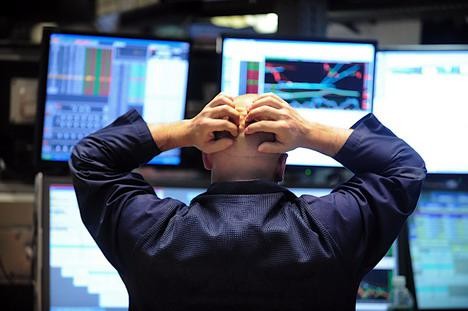Fear factor Investors are scared again The Buzz Investment and Stock Market News
Post on: 21 Июнь, 2015 No Comment

Investors are getting nervous with stocks at all-time highs. But that may not be a bad thing.
The opinions expressed in this commentary are solely those of Paul R. La Monica. Other than Time Warner, the parent of CNNMoney, Abbott Laboratories and AbbVie, La Monica does not own positions in any individual stocks.
It’s not too late to find that perfect, fright-inducing Halloween costume. Might I suggest you go as a Wall Street trader?
Investors are once again pretty scared about where stocks are going next. CNNMoney’s Fear & Greed Index. which measures seven indicators of market sentiment, fell to Extreme Fear levels on Monday.
The move took place as tech stocks plunged and the VIX (VIX). a gauge of volatility that is one of the components of the Fear & Greed Index, spiked more than 13%.
Now it may seem odd that the market is this jittery.
The Dow and S&P 500 are barely below the all-time highs they hit last week. The Federal Reserve has signaled that low interest rates are here to stay for awhile. And the Alibaba (BABA) IPO was a smashing success. What’s not to love?
Related: What will make stocks go even higher?
But all those factors might be helping to create more fear.
With stocks continuing to march higher, you can understand why some investors are nervous about market valuations and are doing their best impersonation of the robot from Lost in Space. (Danger, Will Robinson! Danger!)
The Fed’s willingness to keep rates low also may be setting off some alarm bells among investors who are worried that the central bank is behind the curve in fighting inflation.
Long-term bond yields have been on the upswing after hitting their low point of the year in early August. (Is a month and-a-half a considerable time? Discuss.)
And the Alibaba IPO. If you are at all worried about how 2014 is 2000 all over again, then let’s just say that a 38% pop in shares of a Chinese e-commerce company that most investors have never used is pretty good ammunition for the bubble argument.
So should you be scared? Yes and no.
If you take a closer look at the indicators in our Fear & Greed Index, there are two in particular that are the most worrisome. Stock price strength and stock price breadth are both mired in Extreme Fear territory.
Related: Who’s getting rich of the market? Probably not you
Price strength refers to how many stocks are hitting 52-week highs versus lows. The number of stocks at new peaks is not as high as it normally is as there has been an increase in the number of stocks dropping to 52-week lows. That’s not good.
And on a related note, stock price breadth measures how many stocks are going up or down on a daily basis. Over the past month, a bigger chunk of trading activity took place with stocks that were declining than stocks that were heading higher. Also not good.
But it makes sense. My colleague Matt Egan has already pointed out that more than half of the stocks trading on the Nasdaq are actually down at least 20% from their 52-week high. That puts them in bear market territory.
What’s that mean? The rally we’ve had this year has been pretty shallow. The big gains in the largest stocks on the market, companies like Apple (AAPL). Facebook (FB). Microsoft (MSFT) and Intel (INTC) are helping to lift the broader market.
Now here’s the good news. The Fear & Greed Index has been in Extreme Fear mode several times this year, most notably in early August. But investors have shaken off these fears for the most part.
Many experts have talked about this bull market (which has now been going on since March 2009) as perhaps the most hated rally ever. There are many market skeptics who keep waiting for the rally to end.
The naysayers may eventually be right. But they’ve missed out on an amazing run in stocks while they’ve been sitting on the sidelines questioning the validity of it.
The return of some market volatility is arguably a good thing. Although the VIX is still at relatively low levels, it’s slightly higher now than where it started the year. In 2013, when the Dow, S&P 500 and Nasdaq all surged to double-digit percentage gains, the VIX plunged nearly 25%.
The increased bumpiness may frighten away some investors who are taking too many speculative risks. And it may attract more investors who are hunting for bargains to buy following those proverbial dips.
So investors may have no real reason to be scared until the Fear & Greed Index starts to show signs of Extreme Greed again.
To twist that famous FDR quote, the only thing we have to fear is the absence of fear itself. Complacency is a much bigger cause for concern. We don’t seem to have that here.














